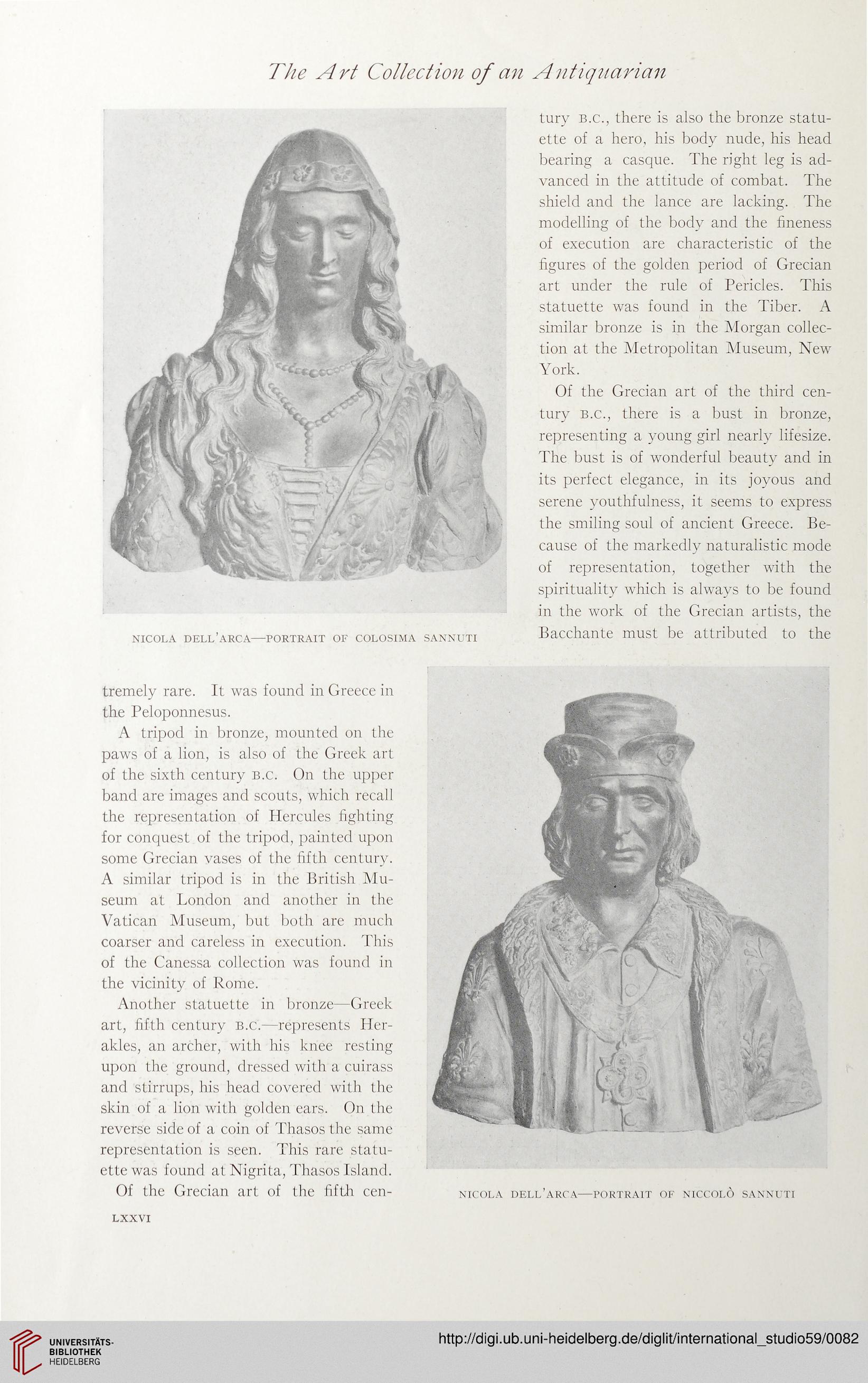The Art Collection of an Antiquarian
NICOLA DELL’ARCA—PORTRAIT OF COLOSIMA SANNUTI
tury b.c., there is also the bronze statu-
ette of a hero, his body nude, his head
bearing a casque. The right leg is ad-
vanced in the attitude of combat. The
shield and the lance are lacking. The
modelling of the body and the fineness
of execution are characteristic of the
figures of the golden period of Grecian
art under the rule of Pericles. This
statuette was found in the Tiber. A
similar bronze is in the Morgan collec-
tion at the Metropolitan Museum, New
York.
Of the Grecian art of the third cen-
tury B.c., there is a bust in bronze,
representing a young girl nearly lifesize.
The bust is of wonderful beauty and in
its perfect elegance, in its joyous and
serene youthfulness, it seems to express
the smiling soul of ancient Greece. Be-
cause of the markedly naturalistic mode
of representation, together with the
spirituality which is always to be found
in the work of the Grecian artists, the
Bacchante must be attributed to the
tremely rare. It was found in Greece in
the Peloponnesus.
A tripod in bronze, mounted on the
paws of a lion, is also of the Greek art
of the sixth century b.c. On the upper
band are images and scouts, which recall
the representation of Hercules fighting
for conquest of the tripod, painted upon
some Grecian vases of the fifth century.
A similar tripod is in the British Mu-
seum at London and another in the
Vatican Museum, but both are much
coarser and careless in execution. This
of the Canessa collection was found in
the vicinity of Rome.
Another statuette in bronze—Greek
art, fifth century b.c.—represents Her-
akles, an archer, with his knee resting
upon the ground, dressed with a cuirass
and stirrups, his head covered with the
skin of a lion with golden ears. On the
reverse side of a coin of Thasos the same
representation is seen. This rare statu-
ette was found at Nigrita, Thasos Island.
Of the Grecian art of the fifth cen-
LXXVI
NICOLA DELL’ARCA—PORTRAIT OF COLOSIMA SANNUTI
tury b.c., there is also the bronze statu-
ette of a hero, his body nude, his head
bearing a casque. The right leg is ad-
vanced in the attitude of combat. The
shield and the lance are lacking. The
modelling of the body and the fineness
of execution are characteristic of the
figures of the golden period of Grecian
art under the rule of Pericles. This
statuette was found in the Tiber. A
similar bronze is in the Morgan collec-
tion at the Metropolitan Museum, New
York.
Of the Grecian art of the third cen-
tury B.c., there is a bust in bronze,
representing a young girl nearly lifesize.
The bust is of wonderful beauty and in
its perfect elegance, in its joyous and
serene youthfulness, it seems to express
the smiling soul of ancient Greece. Be-
cause of the markedly naturalistic mode
of representation, together with the
spirituality which is always to be found
in the work of the Grecian artists, the
Bacchante must be attributed to the
tremely rare. It was found in Greece in
the Peloponnesus.
A tripod in bronze, mounted on the
paws of a lion, is also of the Greek art
of the sixth century b.c. On the upper
band are images and scouts, which recall
the representation of Hercules fighting
for conquest of the tripod, painted upon
some Grecian vases of the fifth century.
A similar tripod is in the British Mu-
seum at London and another in the
Vatican Museum, but both are much
coarser and careless in execution. This
of the Canessa collection was found in
the vicinity of Rome.
Another statuette in bronze—Greek
art, fifth century b.c.—represents Her-
akles, an archer, with his knee resting
upon the ground, dressed with a cuirass
and stirrups, his head covered with the
skin of a lion with golden ears. On the
reverse side of a coin of Thasos the same
representation is seen. This rare statu-
ette was found at Nigrita, Thasos Island.
Of the Grecian art of the fifth cen-
LXXVI




